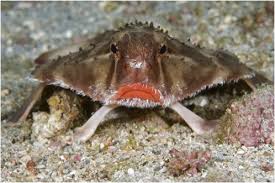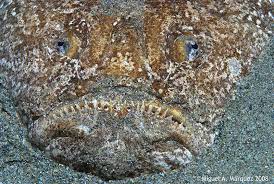Have you ever wondered what are the strangest fish in the world? Here you can find out. There are species that look surprising to say the least and have unique characteristics among fish.
List of weird fish
Blobfish

The blobfish (Psychrolutes microporos) is a fish that attracts attention because of the size and shape of its head. It is gelatinous, large, with a huge mouth and a broad, flattened nose-like protuberance at the end.
These strange fish feed mainly on mollusks, sea urchins and crustaceans.
The blobfish inhabits the waters of New Zealand and eastern Australia. It lives in very deep waters, at about 1000 meters, and is considered an endangered species. This is due to its accidental capture in deep-sea bottom trawling.
Pink handfish

The pink handfish (Brachiopsilus dianthus), is a species of fish that has hand-shaped fins that it uses to move along the seafloor.
It feeds mainly on crustaceans and marine worms.
The pink handfish can only be found on the island of Tasmania in southeastern Australia. These strange fish inhabit the demersal zone, which is found in the water column near the bottom of the sea. It is an endangered animal, this may be due to its reduced mobility which makes it very vulnerable to changes in its environment (such as pollution).
Leafy seadragon

The leafy seadragon (Phycodurus eques) is a type of fish that has the appearance of a dragon with seaweed-like extensions.
The leafy seadragon feeds mainly on plankton, tiny fish and small crustaceans such as shrimp.
It is one of the strangest fish in the world and inhabits the south and west coasts of Australia, from Wilson’s Promontory in Victoria to Jurien Bay. Leafy seadragons live in coastal areas, in warm, shallow water. They are mostly found on sandbanks near rocks covered with seaweed. The biggest threat to this species is man, it is caught for sale as a pet and accidentally in fisheries. Despite this, it is not an endangered species.
Ocean sunfish

The ocean sunfish or mola (Mola mola), is the heaviest bony fish in the world (averaging 1000 kg) and looks like a large head with fins.
These strange fish feed mainly on jellyfish, although they also eat algae, crustaceans, salps, some small fish and fish larvae.
This fish is not located in a specific region, but is found all over the planet. This species inhabits tropical and temperate waters, deep coral reefs and seaweed beds in the open sea. Despite being an animal found in a large part of the planet, it is considered a vulnerable species. Its main threat is humans, it is caught for consumption in some Asian countries and accidentally throughout the world.
Archerfish

The archerfish or banded archer fish (Toxotes jaculatrix) is a type of fish that is characterized by its surprising way of hunting, shooting water jets.
These strange fish are omnivorous and feed mainly on insects out of the water and floating plant matter. The name of the archerfish is given to the 7 species of the genus Toxotes, because of their ability to spit jets of water at insects found on tree branches. They can shoot with great precision at a distance of one and a half meters and with great power that stuns their prey.
This fish is found in the waters of the Indo-Pacific, from India to the Philippines, in Southeast Asia and northern Australia. This species mainly inhabits mangrove swamps, although they can also be found upstream and even in open sea areas close to the coast. The archerfish is very common, and is therefore considered a species of least concern. Its greatest threat is the destruction of mangroves and its capture for sale as aquarium fish.
Longnose gar

The longnose gar, longnose garpike or billy gar (Lepisosteus osseus) is a fish that has hardly changed in millions of years, which is why it maintains a prehistoric appearance.
The longnose gar is a carnivorous animal and generally feeds on small fish and crustaceans. When searching for food, it stays motionless near the surface of the water and allows itself to be carried by the current. If it sees prey nearby, it pounces on it, catches it in its mouth and then swallows it.
These strange fish inhabit the eastern half of North America. This species inhabits rivers and lakes with many aquatic plants. It is very adaptable, tolerating waters with high temperatures and low oxygen. The eggs of this fish are toxic to other animals, including humans. The population of the longnose gar is very large, so it is considered a species of least concern.
Goblin shark

The goblin shark (Mitsukurina owstoni) is a shark with a unique and strange morphology, it stands out for having a long and flattened extension as a snout.
Its most characteristic feature is its flattened and elongated snout, with a triangular shape. In addition, it is capable of unhinging its jaw and propelling it forward to capture prey.
The goblin shark is a carnivorous animal that feeds on teleost fish (such as monkfish and dragonfish), crustaceans (such as crabs, oysters and shrimp) and mollusks (such as octopus and squid).
It is a fish that has been seen in the waters of the Atlantic, Pacific and Indian Oceans (western area). It is therefore found in most parts of the planet. The goblin shark inhabits very deep waters, at about 1300 meters. Although they are very rare fish, their population is estimated to be large and therefore a species of least concern.
Longhorn cowfish

The longhorn cowfish (Lactoria cornuta) is a very strange looking fish, the large horns on its forehead standing out among the other physical features.
In addition to the characteristic horns on the top of its head, it has two more on its body near the anal fins.
The longhorn cowfish is an omnivorous animal that has a very varied diet. It can eat algae, small fish, sea sponges, marine worms, mollusks and crustaceans.
This species can be found in Indo-Pacific waters, from the Red Sea to Japan in the north and Indonesia in the south. These weird fish mainly inhabit coral reefs, but can also be seen in lagoons, estuaries and sandy coastal areas. The longhorn cowfish population is very abundant and widely distributed, therefore it is considered a species of least concern.
Panaque nigrolineatus

The Panaque nigrolineatus is one of the few fish capable of feeding on wood, it also has a very striking appearance.
A very curious feature of this animal is its mouth, which is located at the bottom, is shaped like a suction cup and is full of spoon-shaped teeth.
As we mentioned at the beginning, the panaque nigrolineatus (like the other species of its genus) feeds on wood.
This species is found in South America, mainly in Venezuela, but also in Colombia and Brazil. It is one of the strangest fish in the world and lives in the Orinoco and Amazon rivers, in fast-flowing waters with a lot of vegetation. Finally, the greatest threat to this fish is the pollution of the rivers where it lives. However, the conservation status of this species has not yet been evaluated.
Lionfish

The lionfish (Pterois antennata) is one of the most amazing fish in existence, noted for its spines and incredibly long pectoral fins.
Its characteristic pectoral fins can measure up to 30 cm (a length longer than its body) and when unfolded they resemble a fan. In addition, the dorsal fin is almost as long as the pectoral fins, and has sharp, venomous rays. On the other hand, it has a large head, with a wide mouth, large eyes and two antennae on top of them. These strange fish are usually white in color, with thick brown lines and thinner red and black ones.
The lionfish is a carnivorous animal and feeds on shrimp, crustaceans and small fish.
Lionfish are native to the tropical waters of the Indian and Pacific Oceans. Lionfish inhabit coral reefs and coastal lagoons. Finally, unlike most of the species studied in this blog, the lionfish is experiencing a population increase due to the invasion of new areas and its high reproductive capacity, so it is considered a species of least concern.
Red-lipped Batfish

The red-lipped batfish (Ogcocephalus darwini), also known as the Galapagos batfish, is a type of fish that attracts attention because of its strange appearance.
It has a long tail, and pectoral fins adapted for walking, which, like other strange fish such as the rosefish with hands, it uses to move along the seafloor. It has a large, broad head, large eyes on the sides, a wide mouth with small teeth and characteristic fleshy red lips. The Galapagos batfish is light brown in color.
It is a carnivorous fish, and feeds on small fish, mollusks and crustaceans
This peculiar anglerfish can only be found around the Galapagos Islands (Ecuador) and off the coast of Peru. The red-lipped batfish lives in tropical climates, on the bottom of reefs, coasts and estuaries. It lives at depths between 3 and 76 meters. Despite its strange appearance and limited range, it is considered a species of least concern.
Blue Parrotfish

The blue parrotfish (Scarus coeruleus) is a fish that attracts attention because of its intense blue color and its peculiar beak.
Apart from the intense blue color that covers its body, these strange fish are characterized by their particular dentition, with fused teeth forming a kind of beak. They are omnivorous fish, but feed mainly on algae.
It is an abundant species in its geographic area and is considered a least concern. But overfishing and climate change may pose a threat in the future.
Atlantic stargazer

The Atlantic stargazer (Uranoscopus scaber) is a species of fish that stands out for its hunting behavior and sinister appearance.
This strange fish has a vertically positioned face, so that it always seems to be looking upwards. Its brown color helps it to camouflage itself in the sand, so this carnivorous fish buries itself waiting for some small fish or crustacean to appear.
The Atlantic stargazer inhabits subtropical waters of the Mediterranean Sea and the eastern part of the Atlantic Ocean. As for its conservation status, it is an edible fish, but it is not caught on a large scale. So it is considered a species of least concern.